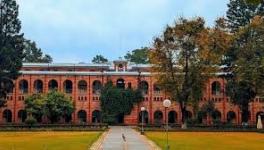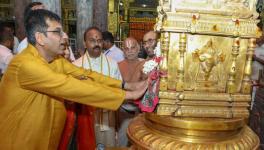Rakhigarhi: NCERT’s New Chapter Flies in Face of History & Science

Representational Image. (File Image)
The National Council of Educational Research & Training (NCERT) is relentlessly changing school curricula and revising textbooks to push pre-determined Hindutva ideological positions. Deletions were made earlier in biology and other subjects’ syllabi and text books for Grades 7, 8, 9 and 10 to deny students’ the knowledge of evolution theory, genetics, biodiversity, forests, natural and mineral resources of India etc.
Whereas the purpose in other subjects was to prevent children from learning about the resources of this country, and their ruthless exploitation and consequent environmental destruction by industrial and commercial corporate interests, the objective in biology, evolution and genetics is to push children away from a scientific understanding and toward a Hindutva version of creationism to be taken literally, ironically never propounded in any ancient Hindu school of thought. A Union government minister had even declared in Parliament that the dashavatar was a better theory of evolution than Darwin’s!
This time, it is another Hindutva myth and completely false historical narrative that is being pushed through a new addition in a chapter titled ‘Bricks, Beads, and Bones – The Harappan Civilisation’ in the Class 12 History textbook Themes in Indian History Part-I. NCERT has added three new paragraphs, supposedly drawing inferences from the analysis of the genetic fingerprints in DNA obtained from a female skeleton uncovered at the Indus Valley Civilisation (IVC) archaeological site in Rakhigarhi in Hisar district, Haryana.
The completely false supposedly “historical” narrative put out in the NCERT textbook is that the DNA evidence from Rakhigarhi disproves the Aryan in-migration theory, which the Sangh Parivar has disputed for long, so as to maintain their ideological belief that the Aryans and the vedic people were fully indigenous, further justifying the Hindutva belief in India as janmabhumi (land of birth), mathrubhumi (motherland) and punyabhumi (holy land).
The NCERT text further states that the Rakhigarhi genetic evidence also shows that the IVC population is totally indigenous and shows an unbroken continuity with the entire Indian population to this day and with the people of the immediate region (i.e, Haryana especially the Jats).
To finally turn on its head the overwhelming genetic evidence showing diffusion of populations from the Central Asian Steppes toward both South Asia and Northern Europe, the new NCERT text asserts that findings of this DNA marker in the wider region outside India prove that in fact the Harappans migrated outward and mingled with people elsewhere!
GENETIC MATERIAL IN RAKHIGARHI
In 1920, ruins of an ancient and quite advanced civilisation, with complex urban settlements and infrastructure were found in Harappa, and were named the Indus Valley Civilization (IVC) since it flourished on the banks of the Indus River.
More evidence of this ancient civilisation was later found at Mohenjodaro in 1921, and many other sites since then. Some British archaeologists had then argued that the IVC preceded the vedic civilisation which had been developed by the “Aryan invasion”, which later destroyed the IVC. Actually, the term ‘Aryan invasion’ has never been used by serious contemporary Indian or international historians who, based on a wide range of historical, archaeological, linguistic and later genetic evidence, have used the term “migration.”
In 1960, archaeological excavations uncovered spectacular new finds in Rakhigarhi, a small village in Haryana. The Rakhigarhi settlement apparently covered a larger area than Harappa or Mohenjodaro. Carbon-dating of many artefacts and other archaeological finds recovered from Rakhigarhi were dated back to 6500 BCE, whereas finds from other layers and Harappan finds date from roughly 3,300 BCE to 1300 BCE, indicating some cultures even earlier than the Harappan.
In any case, many burial chambers and graves with skeletons dating back about 4,500 years ago were found in Rakhigarhi. Bodies were buried in different positions, some alone and others presumably with spouses, and with different artefacts, such as jewellery indicating status. Out of all the skeletons recovered all over the IVC sites, whether in modern day Pakistan or India, only one in Rakhigarhi yielded a sample from which DNA could be sequenced. This was due to the fact that sufficient material was found in the well protected petrous bone that protects the inner ear, such material often yielding almost 100 times more DNA than material from elsewhere in the skeleton.
So, the entire debate, and it was a massive and controversial debate that has not quieted down to date, has revolved around the genetic sequencing of DNA from this one skeleton of a female who lived and died sometime between 2800 and 2300 BCE.
To cut a long story short, the Rakhigarhi DNA sample did NOT contain the much-discussed R1a1 gene, which is considered a definitive marker of Bronze Age pastoralist populations who dispersed from the Central Asian steppes or grasslands in different directions in Europe and South Asia.
SCIENCE VS MANUFACTURED HISTORY
An academic article was published in Cell, a reputed science journal, in October 2019 discussing the Rakhigarhi findings and the conclusions that could be drawn from it. There are 27 authors of this paper representing different disciplines such as archaeology, geneticists etc, titled “An Ancient Harappan Genome Lacks Ancestry from Steppe Pastoralists or Iranian Farmers.”
The publication of this paper was delayed considerably since, as several of the lead Indian authors said in interviews to different newspapers and magazines, the findings were “controversial” and would face opposition from the powers that be. All the 27 authors went along with the scientific facts, arguments and conclusions in the paper itself.
However, things took a different turn in lay discourse in the public domain. The scientific, genetic findings from Rakhigarhi seemed to point in one direction, whereas political-ideological forces were superimposing themselves to offer contrary interpretations.
Findings from other genetic studies among large samples of Indian samples from different regions, ethnic, linguistic, cultural socio-economic and caste backgrounds had also been fanning controversies, often along similar lines. There is much academic and popular debate around these issues, but this is not the place where all the details can be discussed. However, the main points with reference to the claims put forward in the NCERT textbooks are briefly summarised here.
The absence of the R1a1 gene in the Rakhigarhi sample showed clearly that the IVC population had not yet encountered or intermingled with the Steppes people and hence predates their diffusion or migration into South Asia. The larger genetic studies covering hundreds of people selected from different population groups in different parts of the country have shown that the gene markers of the Steppes show up frequently in population groups in northern India who then came to be termed as “Ancestral North Indian” or ANI group, while people in the South did not possess this gene marker and were thus termed as “Ancestral South Indian.”
One of the scientists involved in Rakhigarhi, who later turned ambivalent under pressure, told a journal in an important interview that, while "a mass movement of Central Asians happened and significantly changed the South Asian genetic make-up," (the inhabitants of ancient Rakhigarhi) "do not have any affinity with the Central Asians."
Another of the authors of the Rakhigarhi article, who would later openly start advocating the Sangh Parivar view, insisted in another interview that there was a “continuity” between Rakhigarhi inhabitants and the nearby people of Haryana who, however, showed high presence of R1a genes and Steppe ancestry.
A leading Australian geneticist has described this theory as “utter nonsense” (using a more impolite word that cannot be repeated here!) and also predicted that Rakhigarhi would throw up far more genetic material showing affinity with Ancestral South Indians, some experts say similar to the Irula tribe and the Andaman tribals.
Yet the Sangh Parivar continues to insist on its completely unscientific a-historical, false and completely manufactured narrative that the early phase and later phase Harappans (an earlier acknowledged distinction that NCERT has now deleted from the PUC II history textbook) and IVC people are the same, that “they are the indigenous people of this region,” (i.e, Haryana), that there was never any “large-scale migration” into India, and that “the genetic roots of the Harappans go back to 10,000 BCE. The DNA of the Harappans has continued till today and a majority of the South Asian population appears to be their descendants.”
NCERT once again flies in the face of history and science.
Tapan Mishra is with the Paschim Banga Vigyan Mancha. D Raghunandan is with Delhi Science Forum and All India People’s Science Network. The views are personal.
Get the latest reports & analysis with people's perspective on Protests, movements & deep analytical videos, discussions of the current affairs in your Telegram app. Subscribe to NewsClick's Telegram channel & get Real-Time updates on stories, as they get published on our website.
























